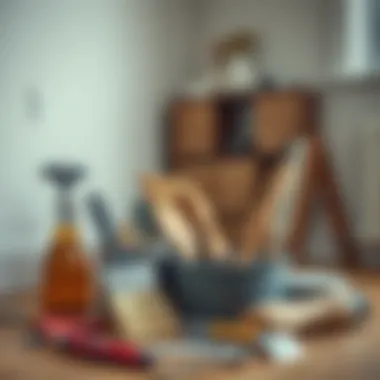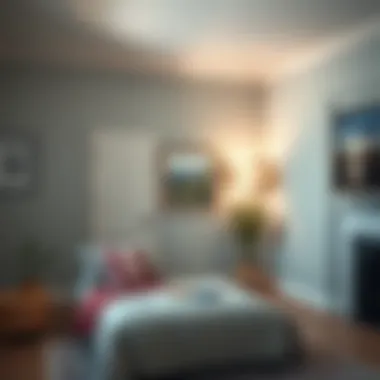Understanding the Costs of Painting a Room in Your Home


Intro
Painting a room in your house can significantly transform its look and feel, but it can also come with a price tag that catches some homeowners off guard. Understanding what factors influence the costs associated with this endeavor is essential, whether you're planning a fresh coat of paint in the living room or you're sprucing up a child’s bedroom. From selecting high-quality materials to deciding whether to go the DIY route or hire professionals, every decision impacts your wallet.
Every homeowner has a budget, often tighter than a drum. This article will break down the various components that comprise the total cost of painting. We’ll look closely at material choices and how their quality can change your expenses. Labor costs, whether hiring help or doing it yourself, will be examined as well.
Key points to cover include:
- The different types of paint and materials that affect costs.
- The size of the room and how that influences pricing.
- A comparison between DIY approaches and hiring experienced painters, helping you weigh your options.
Stay tuned as we set the stage for making informed financial decisions when it comes to painting a room in your home.
Factors Affecting the Cost of Painting a Room
When tackling the task of painting a room, understanding the costs involved can save you a considerable headache later on. There are several key factors that play into the overall expense, and it's essential to grasp these before diving into the project. The right planning can not only trim your budget but also enhance the final outcome of your work. With that in mind, let's break down the major components affecting the cost of painting a room.
Size of the Room
The size of the room you are painting is arguably the largest determining factor of your expenses. The larger the room, the more paint you will need, and typically, more preparation work is required. For instance, a tiny bathroom may only require a couple of gallons of paint, while a spacious living room could demand five or more gallons. Beyond just the paint, larger spaces often need more tools and extended time for both application and drying. When considering this factor, take accurate measurements of your space to estimate the square footage effectively. A visual reference is the formula: Length x Width = Square Footage. This calculation will help you gauge how much product to budget for, ultimately saving you from buyer's remorse at the paint store.
Type of Paint
Not all paint is created equal. The type of paint you choose can significantly affect your overall costs. Options range from budget-friendly latex paints to high-end, durable finishes. For instance, brands like Sherwin-Williams and Benjamin Moore offer exceptional quality, but they can be pricier. On the other hand, a standard store brand may save money upfront but might necessitate more coats or touch-ups later, potentially leading to higher long-term costs. Additionally, factors such as finish—whether matte, satin, or glossy—can also influence price. Keep in mind that buying in bulk or during sales can provide savings in the long-term palette for home improvements. Remember, choosing the right paint is not just a question of aesthetics, but a matter of budget too.
Condition of the Walls
The state of your walls can also make a dent in your budget. If your walls are in poor condition, you might be looking at additional expenses for repairs and prep work. Small cracks and holes may require patching, while peeling paint can demand scraping and sanding. If the walls are dirty, a good washing can improve paint adherence, which might be a step often overlooked. Each of these requirements can add a layer of work, translating not only to higher material costs but also increased labor costs if you're hiring help. Before picking up any brushes, it's wise to inspect the walls carefully. Addressing issues upfront can prevent headaches down the line and ensure a smoother finish.
Labor Costs
Should you opt for professional help or plan to do it yourself, labor costs are a pivotal consideration. Hiring skilled painters might seem like an expenditure at first blush, but their expertise can often save time and lead to superior results. On average, professionals charge $20 to $50 per hour, depending on your geographic location and their experience. Alternatively, if you choose the DIY route, you can save on labor fees but might incur costs related to tools, equipment rentals, and your time. Moreover, consider the opportunity cost of spending your weekend painting instead of enjoying leisure activities. Your personal time has value too. Balancing the labor equation requires weighing these costs against potential quality outcomes.
"Cost is not just a number; it’s a blend of choices that shape your final product."
By keeping these factors in mind, you equip yourself with the necessary knowledge to approach your painting project with confidence. Proper planning of the size, type of paint, wall conditions, and labor dynamics affects not only your budget but also the aesthetic outcome of your home. A little foresight can lead to a situation where you're not just throwing money at a wall but investing in your living space.
Understanding Paint Quality
When deciding to paint a room, paint quality can be just as significant as the color you choose. Paint quality affects not only the way the final product looks but also the longevity and durability of your work. It’s easy to get swept away by the aesthetics, yet understanding what comprises quality paint makes a world of difference. You're not just slapping color onto a wall; this is an investment in your home.
Investing in high-quality paint often means better coverage, which can save time and money in the long run. It typically requires fewer coats, thus reducing labor and material costs. Moreover, quality paint can resist fading, chipping, and other wear-and-tear, prolonging the life of your newly painted room. It also plays a role in environmental factors, such as low volatile organic compounds (VOCs), which are healthier for both your family and the planet.
Comparing Brand Options
The market for paint offers countless brands, each with a unique set of specifications, advantages, and price points. Popular names like Sherwin-Williams, Benjamin Moore, or Behr offer a range of products tailored for various needs. When comparing brands, consider factors like:


- Finish Types: Some brands may specialize in flat finishes, while others shine in satin or semi-gloss.
- Color Selection: A broader palette can ignite creativity, but ensure the brand delivers the shades you desire.
- Reviews and Testimonials: Feedback from previous users can provide insights about durability and ease of application.
While it might be tempting to opt for the less expensive brands, they can sometimes lead to extra costs down the road with more frequent repainting or touch-ups.
Durability versus Cost
When weighing paint durability against cost, it’s wise to take a long-term view. Cheaper paint can appear appealing initially, but if it needs frequent maintenance, any savings are quickly diminished. High-quality paints often come with warranties, which are a testament to their durability. Here are some points to consider:
- Performance: Premium paint generally resists wear better, making it a sound choice for high-traffic areas.
- Finish and Appearance: High-end options offer richer colors and finishes that stand the test of time.
- Application Ease: Quality paint often goes on smoother and covers better, reducing the headaches typically associated with paint jobs.
Ultimately, while durable paint may require a higher upfront investment, its longevity can yield significant savings over time. The old adage rings true here: "you get what you pay for."
"Choosing the right paint isn’t just about color; it’s about making sure that your hard work pays off in the long run."
In summary, understanding paint quality allows homeowners not just to beautify their space but to do so in a manner that is practical and economic. Ensuring that you choose wisely can lead to a well-painted area that stands the test of time.
Estimating Overall Costs
Estimating overall costs is the backbone of any home painting project. Knowing how to balance expenses for materials, labor, and unexpected costs is essential for setting a realistic budget. By breaking down each component of the expenditure, homeowmers can make informed decisions that align with their financial plans. This section dives into key areas homeowners should consider when estimating these costs.
Calculating Material Costs
When it comes to calculating material costs, it's crucial to factor in several elements that contribute to the grand total. Paint is, of course, the most visible expense. However, there are several types of paint to choose from which may influence the price. For instance, premium brands like Sherwin-Williams or Benjamin Moore often come at a steeper price, yet they may offer better coverage and longevity.
Besides paint, other materials are needed:
- Primer: This is often overlooked but is vital for achieving a more polished finish, especially on walls that require extra attention or color changes.
- Tools: Brushes, rollers, tape, drop cloths, and trays are essentials that can add up. Investing in quality tools can save time and backaches in the long run.
- Miscellaneous Supplies: Caulk, sponges, and even ladders might be necessary based on the room’s needs.
Calculating these expenses ahead of time provides a clearer picture of your budget. It's a good practice to get a detailed list of everything you'll need and then shop around. Comparing prices across different local stores or online platforms may unearth better deals. Just keep in mind, that while saving money is great, compromising on quality often leads to more significant expenses down the line.
Assessing Labor Expenses
Labor costs can vary widely and should not be taken lightly. If you're opting for the DIY route, the main expense is your time and effort. Yet, if you're hiring professionals, understanding what’s included in labor costs is crucial.
Here are key considerations:
- Hourly Rates vs. Flat Fees: Some contractors charge by the hour, while others provide a flat rate for a job. Knowing this can aid in comparisons among providers.
- Experience Matters: Experienced painters typically command higher wages, but they often deliver a higher quality result. In contrast, less experienced individuals may seem more affordable, but sometimes can lead to mistakes that cost more in the long run.
- Job Complexity: Rooms that adhere to complex designs or require special finishes will naturally drive up labor costs due to the time and skill required.
- Location: Geographic variations affect labor costs as well. Urban areas tend to have higher rates compared to rural places.
An important tactic is to get multiple quotes and be clear about what is included in each estimate. This facilitates not just a better understanding of the market rates but also gives leverage to negotiate if one quote is significantly higher than others.
“Saving on labor costs is all about weighing the pros and cons. Sometimes paying a little more upfront can save you headaches later.”
In summation, estimating the overall costs of a painting project calls for thorough analysis and consideration. By being meticulous in calculating material expenses and assessing labor costs, you can avoid surprises and work towards a smooth home transformation.
DIY Painting Projects
Diving into DIY painting projects can be a double-edged sword. On one hand, you're saving a good chunk of change by avoiding professional labor costs. On the other, it entails a hefty slice of responsibility, as well as a fair amount of effort. Knowing when to roll up your sleeves and take on the task yourself can significantly affect your overall budget when painting a room.


Before embarking on this journey, consider not just the physical demands but also the financial implications. With rising labor costs across the board, taking matters into your own hands might seem appealing; however, this choice deserves careful thought.
Tools and Supplies Needed
Successfully completing a DIY painting project hinges on the right tools and supplies. Here’s a handy list to get you started:
- Paint: Choose according to the room's function, opt for washable paints in high-traffic areas.
- Paint brushes and rollers: A variety of sizes will help with precision on different surfaces.
- Painter’s tape: Essential for clean lines, especially around edges and trim.
- Drop cloths: Protect your floors and furniture to avoid any mishaps.
- Paint trays: To hold and distribute paint evenly.
- Ladder: A sturdy step ladder is a must for those high-to-reach spots.
- Sandpaper: Smoothens out surfaces pre-painting for better adhesion.
- Putty knife: Handy for filling in cracks or holes before applying paint.
- Cleaning supplies: Soap and water for tools and spills.
Equipping yourself properly may entail upfront costs, but these essential items serve as an investment for potential future projects as well. Remember, buying quality tools can save you headaches later on!
Cost-Saving Strategies
When it comes to DIY painting, who doesn't want to stretch that dollar a bit further? Here are some effective strategies to keep expenses in check:
- Buying in Bulk: If you're tackling multiple rooms or larger spaces, purchasing paint in larger quantities can lead to savings.
- Keep an Eye Out for Discounts: Many local home improvement stores offer seasonal sales or discounts for members.
- Reuse Tools: Instead of splurging on new tools, borrow from friends or family or look for gently used tools at yard sales or on websites like Facebook Marketplace.
- Plan Your Colors: Instead of switching paint colors halfway through the project, choose a palette and stick to it. You save paint and time.
- Do Thorough Prep Work: Spending a little extra time preparing surfaces can reduce the number of coats of paint you need later.
Implementing these strategies not only lessens the financial burden but can also boost your sense of accomplishment once the job is done. Saving money while beautifying your space is a win-win, wouldn't you say?
'The road to a beautifully painted room doesn’t have to break the bank; it just takes a little planning and elbow grease.'
Hiring Professional Painters
When it comes to painting a room, many homeowners grapple with the choice between tackling the project themselves or hiring professional painters. Choosing to hire experts can often save you time and prevent headaches that come with a DIY approach. While you may feel drawn to roll up your sleeves and get right into it, it’s crucial to weigh the benefits of bringing in skilled hands.
Hiring a professional brings a level of expertise that is tough to replicate without experience. These painters understand the subtleties of color mixing, surface preparation, and application techniques. They can save you from costly mistakes. For example, a misstep with paint selection might lead to a shade that looks perfect in the store but transforms into an eyesore on your walls.
Additionally, a seasoned painter is equipped with the right tools and materials, which can otherwise run up your expenses if you decide to invest in them yourself. Some estimates suggest that hiring out your painting project, rather than buying tools for just one job, can be more cost-effective in the long run.
In this section, we will look into how to choose the right contractor and effectively evaluate quotes and estimates to ensure you are getting the best value for your money.
Choosing the Right Contractor
Selecting the right contractor can be as perplexing as deciding on the paint color. Begin by seeking recommendations from friends, family, and neighbors. Personal referrals often yield trustworthy candidates. Furthermore, don’t shy away from diving into online reviews. Websites such as Yelp or Angie’s List can provide a treasure trove of feedback from previous clients.
Once you have a shortlist, consider reviewing their portfolio. Asking for past project references can reveal not only the quality of their work but also their range and versatility in styles. It’s also wise to check if they carry all the necessary licenses and insurance. This will protect you against any mishaps that could occur during the painting job.
Moreover, take the time to have an open dialogue with potential contractors. Discuss their approach to prep work, materials, and timelines. This conversation might illuminate whether they pay attention to the details that matter to you. Remember, trust goes both ways; you'll want someone who listens as closely as they paint.
Evaluating Quotes and Estimates
After narrowing down your choices, the next step is to evaluate the quotes and estimates you receive. Ideally, you should get at least three estimates to make a fair comparison. Each quote should detail the costs, including labor and materials, specified in a way easy to understand.
Consider a quote that breaks down all components. It not only helps you see where your money is going, it also offers leverage for negotiation. A good contractor will be willing to explain their pricing structure and justify any high expenses.
Pay attention to red flags in estimates. If one contractor’s quote is significantly lower than the others, it could spell trouble. A drastically reduced price might mean corners will be cut somewhere, whether it’s in labor hours or material quality.
Before making a decision, it’s advisable to schedule a follow-up meeting with your preferred contractor to go over any questions. Do not ignore those gut feelings – if something feels off, it might be worth exploring other options.


"When hiring a pro, you’re not just paying for their time, but for their skill and knowledge gained through experience."
Overall, hiring professionals can lead to a superior finish that enhances your home's appeal and value. Balancing cost with quality against your personal vision is paramount. By carefully considering your contractor choices and scrutinizing quotes, you can take significant strides toward making a smart investment in your home.
Hidden Costs to Consider
When embarking on a painting project, many homeowners are mainly focused on visible expenses like paint, brushes, and hiring a painter. Yet, it’s crucial to pay close attention to the hidden costs that can sneak up on you, affecting your budget significantly. These unforeseen elements can indeed turn a seemingly straightforward task into a financial puzzle that requires thoughtful planning.
Preparation and Cleanup Expenses
Before the brush even hits the wall, there are preparatory tasks needed to ensure a smooth painting experience. This includes everything from moving furniture to covering floors and taping edges, to properly ventilating the space.
- Time Factor: Often overlooked, the time spent on preparation can add up. If you're doing it yourself, consider how long these tasks will take away from your regular schedule. Households often have to dedicate a weekend or longer, impacting family time.
- Materials for Protection: Protecting your space requires additional materials like drop cloths, tape, and plastic sheeting. Don’t forget to factor in the costs of these supplies. Even the paint itself often requires a primer, adding layers to your spending.
- Cleanup Duty: Once the painting is done, a hefty cleanup effort awaits. Cleaning brushes, disposing of leftover paint, and restoring furniture and fixtures to their original positions all represent additional costs in terms of both your time and effort.
In short, while the main expenses might seem apparent, neglecting these preparatory and cleanup expenses could mean you’re not seeing the whole picture of your budget.
Potential Repairs
Alongside what’s visible, there may be issues lurking beneath the surface that need attention before you can proceed with painting. Preparing walls can sometimes expose structural issues or damages that weren't initially apparent.
- Wall Integrity: If your walls are cracked or have holes, you might need to patch them up before applying any paint. This requires materials like spackle or joint compound, which are additional costs that can add up quickly.
- Mold Treatment: In areas prone to dampness, such as bathrooms or basements, mold can often be found lurking. A treatment for mold not only costs money but also time for proper application and later cleanup.
- Drywall Replacement: In more severe cases, you may find that you need to replace entire sections of drywall, which significantly increases your budget. A patch-up might turn into a full repair, so always be prepared for unexpected fixes.
"Budgeting for potential repairs can save your project from becoming a budget buster—always have a little extra set aside just in case."
Monitoring these hidden aspects of the painting process promotes financial transparency. Being informed about these often-overlooked costs will help you allocate your budget smartly and avoid pitfalls that could derail your project. For more tips on budgeting for home renovations, check out The Balance.
Whether you’re a DIY enthusiast or someone looking to hire a pro, these hidden costs serve as a valuable reminder that a comprehensive budget should cover every angle of your painting endeavor.
Long-term Financial Implications
Understanding the long-term financial implications of painting a room goes beyond immediate costs, playin a significant role in your overall investment in your home. Homeowners often overlook how an interior paint job can affect property values and future expenses. It’s essential to look at both the added value to your home and the potential maintenance costs that can arise later on.
Investing in quality paint and professional help can increase your home's appeal, making it more desirable to potential buyers. Even if you think you'll never sell, situations change, and having that painted room might give you a few extra bucks down the line when it’s time to move. A clean, well-maintained appearance signals to buyers that the property has been cared for, enhancing its marketability.
Moreover, keen awareness of maintenance costs is equally important. Over the years, paint can peel, fade, or show signs of wear and tear due to various factors like humidity or sun exposure. Understanding the frequency of maintenance or touch-ups needed can greatly impact your budget in the long run, so factor this into your decision-making process when painting.
"You might not notice those little things until they're big problems, it's vital to stay ahead and keep things fresh."
Impact on Home Value
The impact of a fresh coat of paint on home value cannot be underestimated. In many cases, a simple, well-executed paint job may yield a return on investment far exceeding the money spent.
- Color Choices Matter: Neutral colors often provide a broader appeal; consider shades like beige, soft gray, or even a light blue.
- Location Influence: In some neighborhoods, having outdated colors can detract from value; staying in line with neighborhood aesthetics can be beneficial.
- Condition of Paint: Quality matters—cheap paint can lead to more issues down the road. If your paint starts to peel after just a few seasons, potential buyers will see that as a red flag.
The curb appeal of your home can significantly influence its market value. A freshly painted room can serve as a selling point for prospective buyers who may see it as a minimal hassle and a maximum reward.
Maintenance Costs Over Time
Maintenance costs, while often a secondary consideration, play a crucial role in the big picture of painting costs. Regardless of how well you maintain that newly painted room, the fact is that paint deteriorates over time, exposing your walls to potential issues.
- Regular Touch-ups: It’s good practice to touch up chips and scratches as they appear—this prevents larger problems later. Each minor touch-up might not feel significant, but neglect can lead to needing a full repaint sooner than anticipated.
- Environmental Factors: Rooms with high humidity, such as bathrooms, may need more frequent maintenance due to mold and mildew development. Also, areas that get a lot of sunlight can experience faster fading, necessitating touch-ups sooner.
- Unexpected Repairs: Damage from a leaky pipe or even a stray piece of furniture can necessitate repainting, adding unforeseen costs.
It's essential to have a maintenance schedule in place and a budget for these expenses to keep your home looking its best over the years. Remember, some investment upfront can save you money down the road, helping to preserve both the aesthetics and the value of your property.







